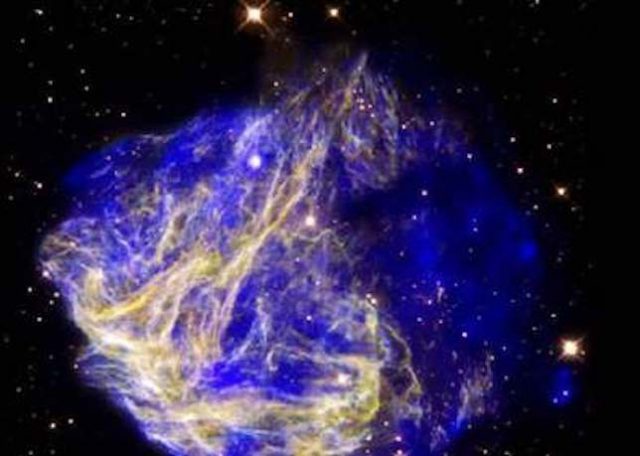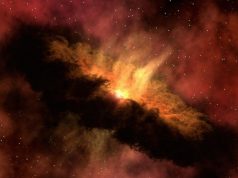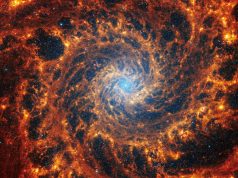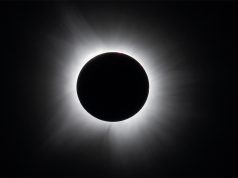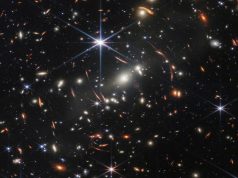SAN FRANCISCO, CALIFORNIA | Astronomers have captured multiple images of a Type Ia supernova, namely the brilliant explosion of a star, appearing in four different locations on the sky, as it was through the “magnifying glass” of a galaxy sitting 2 billion light years away from Earth.
The phenomenon known as “gravitational lensing” is an effect of Albert Einstein’s Theory of Relativity, that mass bends light, meaning the gravitational field of a massive object, such as a galaxy, can bend light rays that pass nearby and refocus them somewhere else, causing background objects to appear brighter and sometimes in multiple locations.
However, “it is extremely difficult to find a gravitationally lensed supernova, let alone a lensed Type Ia.
Statistically, we suspect that there may be approximately one of these in every 50,000 supernovae that we identify,” said Peter Nugent, an astrophysicist at in the Computational Research Division (CRD) of Lawrence Berkeley National Laboratory (Berkeley Lab) and an author on two recent papers, one published in Astrophysical Journal Letters and the other published in the journal Science.
Fortunately, by taking a closer look at the properties of the rare event, namely the 4 billion years old Type Ia supernova, iPTF16geu, Nugent and one of his colleagues at Berkeley Lab have come up with a method, called a pipeline, for identifying more of these so-called “strongly lensed Type Ia supernovae” in existing and future wide-field surveys.
Astrophysicists believe that if they can find more of these magnified Type Ia’s, they may be able to measure the rate of the universe’s expansion to unprecedented accuracy and shed some light on the distribution of matter in the cosmos.
“Since the discovery of iPTF16geu,” Nugent said, “we now have some thoughts on how to improve our pipeline to identify more of these events.”
The process of identifying transient events, like supernovae, begins every night at the Palomar Observatory in Southern California, where a wide-field camera mounted on the robotic Samuel Oschin Telescope scans the sky. As soon as observations are taken, the data travel more than 640 kilometers, or 400 miles, to the U.S. Department of Energy’s (DOE’s) National Energy Research Scientific Computing Center (NERSC), which is located at Berkeley Lab. At NERSC, machine learning algorithms running on the facility’s supercomputers sift through the data in real-time and identify transients for researchers to follow up on.
On September 5, 2016, the pipeline identified iPTF16geu as a supernova candidate.
At first glance, the event didn’t look particularly out of the ordinary. Like most supernovae that are discovered relatively early on, this event got brighter with time. Shortly after it reached peak brightness, Stockholm University Professor in Experimental Particle Astrophysics Ariel Goobar decided to take a spectrum, or detailed light study, of the object.
The results confirmed that the object was indeed a Type Ia supernova, but they also showed that, surprisingly, it was located 4 billion light years away. A second spectrum taken with the OSIRIS instrument on the Keck telescope on Mauna Kea, Hawaii, revealed another galaxy located about 2 billion light years away that was acting as a gravitational lens, which amplified the brightness of the supernova and caused it to appear in four different places on the sky.
“I’ve been looking for a lensed supernova for about 15 years. I looked in every possible survey, I’ve tried a variety of techniques to do this and essentially gave up, so this result came as a huge surprise,” said Goobar, who is lead author of the Science paper. “One of the reasons I’m interested in studying gravitational lensing is that it allows you to measure the structure of matter — both visible and dark matter — at scales that are very hard to get.”
According to Danny Goldstein, a University of California, Berkeley, astronomy graduate student and an author of the Astrophysical Journal letter, there have only been a few gravitationally lensed supernovae of any type ever discovered, including iPTF16geu, and they’ve all been discovered by chance.
“By figuring out how to systematically find strongly lensed Type Ia supernovae like iPTF16geu, we hope to pave the way for large-scale lensed supernova searches, which will unlock the potential of these objects as tools for precision cosmology,” Goldstein was quoted as saying in a news release from UC Berkeley.

